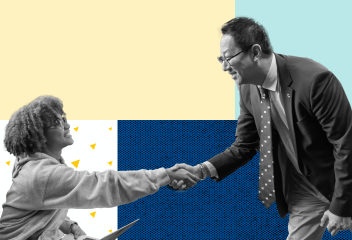For nearly two centuries, Michigan has strived to broaden its diversity and strengthen its inclusiveness. While some initiatives were successful, many other efforts failed to meet the university’s high expectations and goals. It was this imperfect history, coupled with a strong tradition of pursuing positive change, that led to the launch of DEI 1.0, a concerted effort to create a diverse, equitable and inclusive environment for our entire campus community.
The Introduction of DEI 1.0
Building on the wisdom sourced from DEI Leaders and community members regarding campuswide DEI needs and priorities, U-M took a major step toward advancing the ideals of diversity, equity and inclusion by developing its first five-year strategic plan. Launched as a presidential initiative in 2016, the plan sought to be as inclusive as possible, engaging all sectors and constituents of the campus community throughout the planning process. Throughout the entire span of DEI 1.0 implementation, strong and innovative leadership empowered the university to implement far-reaching foundational change at every level, in every unit, and in ways that have impacted every individual on campus.
These collaborative efforts and strategic interventions have also enabled Michigan to successfully navigate an array of challenges and crises, among them: seismic economic, social and political shifts caused by the COVID-19 pandemic; a national reckoning provoked by the murders of George Floyd and Breonna Taylor; the emergence of the Black Lives Matter movement; and an unprecedented level of nationwide political division and unrest.
The Launch of DEI 2.0:
Guiding Principles for Our DEI Efforts
Building on the work begun during DEI 1.0, our DEI 2.0 plan continues to reflect a concerted effort by the university to acknowledge, analyze and understand its complex relationship to the community it serves, and to use those understandings as the foundation of a more diverse, equitable and inclusive present and future.
With those goals in mind, DEI 2.0 is guided by the following principles:
(1) We will strive for organizational change in the service of greater diversity, equity and inclusion. As with DEI 1.0, our new five-year plan calls for each school, college and unit to oversee an ongoing process that involves planning, implementing and assessing specific, achievable and sustainable goals and actions.
(2) Organizational change will be achieved through a dynamic process of year-over-year planning, implementation and assessment of the unit-level and campuswide DEI plans. The year-over-year assessment workflow is intended to emphasize DEI in terms of strategic priorities; build a campuswide effort; develop institutional and constituent capacity to implement and improve DEI initiatives; fully institutionalize DEI into the university; and ensure continued progress and long-term sustainability.
(3) Tracking metrics will indicate whether specific shifts up or down, or lack of activity, represent positive outcomes relative to progress toward our goals of creating a more diverse, equitable and inclusive campus. Units will continue to review and update their DEI plans on a regular basis to reflect both progress toward goals and newly identified opportunities and challenges. By way of example, at the conclusion of DEI 1.0, the university conducted a two-year evaluation and planning process to assess longer-term measures as well as shifts in climate and key indicators of equity across all populations.
(4) Self-evaluation helps to identify which “institutionalization” components (policy, practices, structures, culture, and climate) or dimensions (constituents, campus, community) are progressing well and which need more attention. During DEI 1.0, each school, college and unit was encouraged to collect information relating to its successes, challenges and overall progress. That information was then used to report data-informed evidence of DEI Plan implementation. This process will continue.
(5) Communicating self-evaluation results to key audiences is integral to accountability, continuous improvement and future planning. Summative evaluation of DEI 1.0 provided critical information to university and unit leadership, enabling them to demonstrate accountability for their financial allocations and preparing them to make decisions regarding DEI 2.0.
(6) We will measure progress of organizational change as evidenced through indicators of change in policy, practices, structures, culture and climate. When a school, college or unit makes measurable progress in terms of incorporating DEI into its structures, policies, practices and procedures, the university as a whole advances in its goal of improving the campus culture and climate.
In Summary: Looking Ahead, Moving Ahead
Current research on organizational culture in higher education suggests that substantive institutional change can take nearly 20 years to achieve. Therefore, having assessed the progress and sustainability of our achievements, we now move forward to DEI 2.0 and beyond.
We are resolved to be patient and persistent in our commitment to the goals of DEI and in our actions to bring about lasting change. Only by so doing can we hope to achieve a more diverse, equitable and inclusive University of Michigan for all, a place where every community member can flourish and thrive, both academically and personally, and a place that truly serves the public good.
